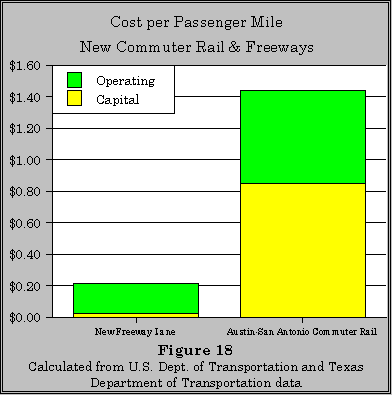This is copied exactly as written in
the Plan "benefits of projects in a multi-modal
plan are hard to disaggregate because they are often synergistic (e.g.,
local shuttles are more effective in conjunction with rail). Therefore, traditional measures of things like
cost-effectiveness are not appropriate.". What kind of
consultant is the county using that thinks they can plan $1.5 billion
transportation changes without any COST-EFFECTIVENESS ? Where is the
source of their data? Its not on their website.
The Plan stresses a "Multi-Modal solution" to our
traffic problems, including rail. Translated:-
divert much needed money away from the most cost-effective solution.
- towards rail etc.. instead of freeway.
On Hwy 101 at San Rafael
- in One Lane during the morning rush hour - 2,300 vehicles pass thru per hour. One
Hwy101 freeway lane "conducts" more than 25,000 vehicles per
day. Compare that to the SMART rail prediction of saving a
maximum of 1,900 car trips per
day. The number of commuters in 2,300 vehicles per hour per
freeway lane, when including Rapid Bus,
increase considerably.
Why does the plan not include the option of adding a
freeway lane in each direction over the entire route? It would cost $250 million, $50 million more than building the
commuter rail line but when converted to a cost per
passenger mile, the capital cost of the commuter
rail line is more than 4 times as much as the freeway lane. (the above numbers exclude the Novato-Petaluma
Narrows which needs to happen rail or no rail )
Another quote from the plan doc: "If development is done carefully under smart growth
concepts, growth will not increase traffic congestion but will instead
improve the viability of transit and other alternative transportation
modes.". ANY
development will increase traffic and thus contribute to congestion and
air pollution, even if it were 100% affordable. Why? Because so few people
choose rail (and bus).
Sales tax funds could also be used to help facilitate smart growth
development within the rail corridor. Bill AB2224: two-thirds
of Marin and Sonoma County residents who live within the District can be asked to approve a sales tax measure. A
half-cent sales tax would generate $21 million in Marin County in its
first year, not enough.
The expense of the 4 interchanges on the
Novato-Petaluma Narrows, conversion to freeway, may be avoided. Its not
unheard of to have a 3 lane highway that is not a freeway.
The Austen-SanAntonio commuter
rail and other projects the "per passenger mile cost of
a new freeway lane in each direction" would have been less than a
tenth the cost of its commuter rail (see below).
(Most of the freeway cost involves the private cost of automobile
operation). Taxpayer subsidies
on commuter rail per passenger mile are more than 50 times the government funding that would be required to build another
freeway lane. (highway user fees, including gasoline
taxes). SMART is 20 times.
http://www.tppf.org/transit/commuter/tran6b.html
|
|
 One Freeway lane carries 2,700 vehicles per hour at peak
periods. One Freeway lane carries 2,700 vehicles per hour at peak
periods.
SMART Rail would have "Daily Home-Based Work Trip Boardings Northbound of 1,416 and Daily Home-Based Work Trip
Boardings Southbound 4,562."
(maybe)
SMART Commuter Rail:-
with service every 30 minutes during the most congested times of day,.
"may remove an estimated 1,900 auto trips from
Highway 101 during the morning commute from 6AM to 9AM".
Apparently only 3 trains can be accommodated on this single track at this
time of day!
The IJ Article on the Transportation Plan
Sonoma's Transport Plan |
|
One of the reasons we find
ourselves with no money to pay for needed freeway
expansion is lack of accountability of developers (and local government
planners). There is no proper correlation between freeway funding and the
development that congests it. And this needs to be done at all communities where
the freeway is affected, no matter how far the development is from the freeway.
In the case of Hwy101, here, both counties, Marin and
Sonoma have to collect mitigating fees to be allocated to 2 separate pools.
One for local traffic and another for Freeway.
Traffic Mitigation Fee Ordinance
Several cities as well as the County have already adopted fee ordinances that
enable local governments to collect fair-share participation fees for needed
public transportation improvements from new development projects that generate
traffic. State law requires local governments to demonstrate a nexus between the
transportation impacts of a project and the fee assessed. This is not a stable
source due to the uneven pace of development. Counties that have local
transportation sales tax revenues are generally able to attract $2 or $3 dollars
of outside funds for every $1 they spend in local money.
In accordance with Program T14.1a of the Tamalpais Area Community Plan, the County adopted the Traffic Mitigation Fee Ordinance which
established the traffic mitigation fee to be imposed for each
single-family residence to be constructed after 1993. The rate of the traffic
mitigation fee charged to each residence was
based on the ultimate reasonably foreseeable build-out of Tam Valley in order to
maintain a Level of Service D along the State Route One corridor through Tam
Valley. Recommended Condition 28 (d) requires the project sponsor to pay a
traffic mitigation fee of $4,267.80 per residence to mitigate the five
additional trips generated by the proposed project. The fee would be modified by
the Engineering News Record index to account for construction cost changes from
February 2000 to the time the fee is paid.
|

